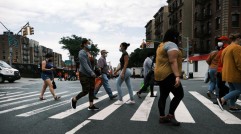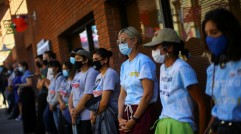Hispanic And Latino Brothels, Prostitution Rising in American Cities
A recent study commissioned by the Justice Department and conducted by the Urban Institute think tank that investigated the sex trade in eight big American cities: Miami, Dallas, Washington, D.C., Denver, Kansas City, San Diego, and Seattle. One major revelation found out in the study was that Hispanic prostitutes and pimps are a growing part of the sex trade. The overall national demand for sex work does not appear to be in a state of growth, with industry earnings shrinking by as much as 37 percent in five of the major American cities, grossing a mere $40 million annually compared to the $32 billion figure that accounts for the human sex trade worldwide.
Most men prefer real girlfriends, according to The Economist, which explains the decline in wages for sex workers over the years: "The demand for sex probably does not change much over time, but other things do. A century ago, when sexual mores were stricter, prostitution was more common and better paid (see table). Men's demand for commercial sex was higher because the non-commercial sort was harder to obtain -- there was no premarital hook-up culture. Women were attracted to prostitution in part because their other job opportunities were so meagre. And they commanded high wages partly because the social stigma was so great -- without high pay, it was not worth enduring it," the March print edition reports.
The recent data has found that in cities such as Miami, for example, brothels are primarily operated by Hispanic or Latino men and women. One of the officers who was interviewed says, "What we've been seeing in the last one [investigation] we did is a lot of the girls were doing it voluntarily at that point, [but] had been trafficked [smuggled and then trafficked] in seven, eight years ago. They paid their debt off and they stayed down there. They know how to make money now so they do it voluntarily. They're much older now, not very attractive, it's kinda like this is all they got."
The women and girls involved are typically from Mexico, Honduras, El Salvador, and Guatemala. Minors are also sex trafficked with many of them being voluntarily involved but at one point were smuggled to the United States at a young age and forced to work in the underground commercial sex trade (UCSE) in order to pay off their smuggling debts. Much of the trafficking takes place through individual families with connections to coyotes, or smugglers, rather than organized crime syndicates, although Mexican cartels help to facilitate the smuggling of women and children from Mexico. Migrant farmworkers comprise most of the client base for Latino brothels, and Law enforcement officials estimate some brothels serve upwards of 80 customers daily and typically charge $25 for 15 minutes.
Aside from brothels, the human sex trade in major American cities also includes internet-based trafficking and erotic massage parlors in addition to street-based prostitution. Street-based prostitution, which has the lowest prices, is in decline as girls increasingly ply their trade in strip clubs and massage parlors or the internet, which are all safer compared to the streets. Websites such as Craigslist, Backpage, and Eros that advertise commercial sex are typically more expensive than brothels or street-based commercial sex, but less expensive that escort services. Websites advertising escort services offer more high-end prices, from $600 to $1000 per hour, and attract wealthier clients.
Looking at San Diego as an example, street and internet based prostitution is primarily run by African American males aged 16-22, half of whom are involved in gangs. Street prices range from $40 for a hand job, $60-80 for oral sex, and $80-120 for "full service." Internet prices range from $120-140 for a half hour and $200 for an hour. Escort services are mainly independent operators who are mainly women. Prices range from $150-500 to show up, plus an additional several hundred to several thousand for sex acts. In the case of an escort agency, there will be a 60-40 or 80-20 split between the girl and her agency. The erotic massage parlors are run by Asians, primarily Chinese and charged $60 for a nonsexual massage and $60-120 per sex act. Workers keep $10 from the massage, tips, and what they earn through sex acts. Brothels are run by Latino men, especially migrant camp brothels, which are closed to the public and charge $20-80 in cash for a variety of sex acts.
One San Diego law enforcement officer explained that rarely has law enforcement in San Diego found Hispanic gangs involved in the underground commercial sex trade: "The majority of our drug trafficking and weapons trafficking deal with Hispanic street gangs and cartel and then they distribute it out to everybody else. With the prostitution and the human trafficking, it's predominantly black gangs. Hispanics, it's kind of I know it's going to occur, but generally it's sex trafficking, rapes, things like that are taboo within the Hispanic street gangs as the rules put for them by the prison gangs because the prison gangs dictate to the street gangs the rules."
San Diego's large number of migrant camps and proximity to Mexico makes it a large market for underground commercial sex activities. The brothels are designed to keep the workers in the fields happy and johns pay $20 to $80 in cash for a variety of sex acts, according to law enforcement officials. "It's like having sex in a PE-room, and up the road from there it was girls' underwear, condoms, beer bottles, so you can just picture how this looks, with everybody lined up -- no shame. But I think the money is there. Obviously it's there or it wouldn't be around as long as it has been. The money that they ask for per service is less but they deal more of it."
The 348 page study was conducted by Meredith Dank (PhD), P. Mitchell Downey, Cybele Kotonias, Deborah Mayer, Colleen Owens, and Laura Pacifici of the Urban Institute. Non-Urban Institute researchers in the study included Bilal Khan (PhD) of John Jay College and Lilly Yu of Rice University. The study is titled "Estimating the Size and Structure of the Underground Commercial Sex Economy in Eight Major US Cities" and was supported by Award No. 2010-IJ-CX-1674, awarded by the National Institute of Justice, Office of Justice Programs in the U.S. Department of Justice.
According to VOXXI, most clients hold a misconception that women in sex rings participate voluntarily and enjoy the work they do. Clients aren't aware of the fact that women in sex rings are coached to fake orgasms and do whatever it takes to please the client and by not doing so they expose themselves to being hurt or having their families targeted.
"According to research from the University of Portland, the average male in the United States who visits a prostitute is usually likely to have served in the military, only slightly less likely to be married and white, and only slightly more likely to have a full-time job and be more sexually liberal," Gillette writes.
"Despite the common assumption that men who pay for sex are looking to dominate or hurt a woman, data suggests this is not the case; most men paying for sex truly believe a prostitute wants or desires sex on a level incomparable to most other women -- including wives and significant others."
Subscribe to Latin Post!
Sign up for our free newsletter for the Latest coverage!














